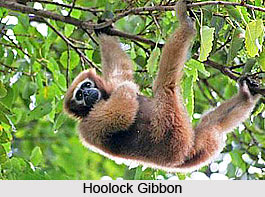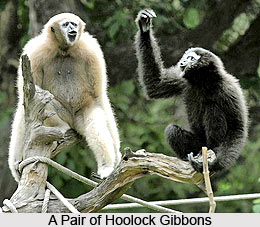 Hoolock or white-browed gibbon (Hylobates hoolock) is the only ape found in India. It is small (head-and-body length 45.7 cm to 63 cm, weight 7 kg to 7.9 kg), has no tail, and its long arms, which are nearly as long as its legs, are specialized for suspensory locomotion in forest canopy. Males and females show little or no sexual dimorphism in size or weight. Young Hoolocks are born a pale greyish white, but within several weeks their coat darkens to glossy black. Only the eyebrows remain white. Males remain black, but females undergo a second colour change at sexual maturity (seven to eight years of age). Their black coat fades to a light buff and with age the chest of many females may become dark brown.
Hoolock or white-browed gibbon (Hylobates hoolock) is the only ape found in India. It is small (head-and-body length 45.7 cm to 63 cm, weight 7 kg to 7.9 kg), has no tail, and its long arms, which are nearly as long as its legs, are specialized for suspensory locomotion in forest canopy. Males and females show little or no sexual dimorphism in size or weight. Young Hoolocks are born a pale greyish white, but within several weeks their coat darkens to glossy black. Only the eyebrows remain white. Males remain black, but females undergo a second colour change at sexual maturity (seven to eight years of age). Their black coat fades to a light buff and with age the chest of many females may become dark brown.
Habitat of Hoolock
Two subspecies of hillocks are recognized: one is found east of the Chindwin River in Burma, and the other is found west of the Chindwin to Brahmaputra River in the eastern India (Assam and Nagaland). Hoolock gibbons once occurred throughout much of Assam, Burma, Bangladesh and parts of southern China, but their present distribution has been reduced considerably. This is attributed to increasing human populations and expanding jhuming (slash-and-burn agriculture) that has eliminated much of the evergreen and mixed evergreen rain-forest upon which these strictly arboreal apes are dependent. Extant populations of hoolocks are restricted to where forests still persist in hilly terrain of North Cachar, Garo, United Khasi-jaintia and parts of Lakhimpur and Tirap provinces of Assam. They also occur in the Chittagong Hill Tracts of Bangladesh bordering Arakan in Burma.

Hoolock gibbons live in small groups comprising of a monogamously mated adult pair and up to four offsprings. Adults mate for life, which may be thirty years or longer. Young are born singly, every two to three years, remating with the group until they are sexually mature. Births appear to be seasonal, generally occurring in the winter months. At maturity offsprings disperse, partly in response to the gradual increase in aggression by the adults. Males must then find sufficient space to establish a territory and attract a mate. Territory generally has clearly defined-boundaries which are respected by neighbouring groups and vary in size depending on the number and distribution of fruit trees within them.
Diet of Hoolock Gibbon
Fruit trees are especially important because fruit is the principal item in the hoolock`s diet. They also eat leaves, young shoots and buds, insects and spiders, and occasionally small birds and eggs. Water is gained by licking dew or rain from vegetation or by wetting and licking the hand.
Songs of Hoolock Gibbon
The loud morning songs of Hoolock gibbons, which last for about fifteen minutes, are an elaborate duet between the adult pair. The song includes an accelerated passage of alternating high and low notes that gradually become shriller. The song is unusual compared to songs of other gibbons in that there are no clear male and female parts. Songs are generally given two to three hours after sunrise, or, only rarely, in the afternoon. Once a group begins to sing, adjacent groups usually remain quiet until the first group is finished. Thus, Hoolock songs pass sequentially through the forest, one group after another, until all the groups have called. Songs are believed to be important in attracting a mate, and once mated, in maintaining the territory.



















